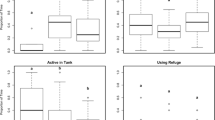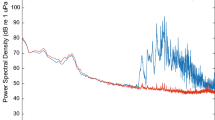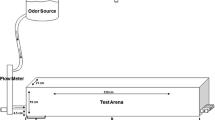Abstract
The responses of individuals of four sympatric species of cambarid crayfish to the introduction of the odor of a common predator, the snapping turtle Chelydra serpentina, were recorded in the laboratory. Adult Orconectes virilis spent significantly more time in a lowered posture and reduced the frequency of nonlocomotory movements following introduction of snapping turtle odor but showed no change in behavior upon introduction of the odor of painted turtle (Chrysemys picta). Recently released young O. virilis did not respond to snapping turtle odor initially but did so after turtle odor and conspecific alarm odor had been paired. Individuals of O. propinquus did not respond to snapping turtle odor. Initial tests with O. rusticus did not yield any response to snapping turtle odor but after experience with paired turtle and alarm odor, individuals showed a decrease in nonlocomotory movements when just snapping turtle odor was introduced. Individuals of Cambarus robustus spent less time in the lowered posture, less time in their burrow, and more frequently executed nonlocomotory movements, in response to snapping turtle odor. The differences in responses to the odor of a common predator are correlated with ecological differences among the crayfish species.
Similar content being viewed by others
REFERENCES
Blake, M. A., and Hart, P. J. B. 1993. The behavioural responses of juvenile signal crayfish Pacifastacus leniusculus to stimuli from perch and eels. Freshwater Biol. 29:89-97.
Butler, M. J. IV, and Stein, R. A. 1985. An analysis of replacement mechanisms governing range expansion in crayfish. Oecologia 66:168-177.
Capelli, G. M., and Munjal, B. L. 1982. Aggressive interactions and resource competition in relation to species displacement among crayfish of the genus Orconectes. J. Crust. Biol. 2:486-492.
Chivers, D. P., Wisenden, B. D., and Smith, R. J. F. 1996. Damselfly larvae learn to recognize predators from chemical cues in the predator's diet. Anim. Behav. 52:315-320.
Crocker, D. W., and Barr, D. W. 1968. Handbook of the crayfishes of Ontario. Royal Ontario Museum Misc. Publ. 158 pp.
DiDonato, G. T., and Lodge, D. M. 1993. Species replacements among Orconectes crayfishes in Wisconsin lakes: The role of predation by fish. Can. J. Fish. Aquat. Sci. 50:1484-1488.
Garvey, J. E., Stein, R. A., and Thomas, H. M. 1994. Assessing how fish predation and interspecific prey competition influence a crayfish assemblage. Ecology 75:532-547.
Hazlett, B. A. 1990. Source and nature of the disturbance-chemical system in crayfish. J. Chem. Ecol. 16:2263-2275.
Hazlett, B. A. 1994. Alarm responses in the crayfish Orconectes virilis and Orconectes propinquus. J. Chem. Ecol. 20:1525-1535.
Hazlett, B. A. 1996. Organisation of hermit crab behavior: Responses to multiple chemical inputs. Behaviour 133:619-642.
Hazlett, B. A. 1997. The organisation of behaviour in hermit crabs: Responses to variation in stimulus strength. Behaviour 134:59-70.
Hill, A. M., and Lodge, D. M. 1994. Diel changes in resource demand: Competition and predation in species replacement among crayfishes. Ecology 75:2118-2125.
Hobbs, H. H., III. 1993. Trophic relationships of North American freshwater crayfishes and shrimps. Contril. Milwaukee Pub. Mus. 85:1-110.
Keller, T., and Hazlett, B. A. 1996. Mechanical use of crayfish chelae. Mar. Fresh. Behav. Physiol. 28:149-162.
Kiesecker, J. M., Chivers, D. P., and Blaustein, A. R. 1996. The use of chemical cues in predator recognition by western toad tadpoles. Anim. Behav. 52:1237-1245.
Mather, M. E., and Stein, R. A. 1993. Direct and indirect effects of fish predators on a crayfish species replacement. Can. J. Fish. Aquat. Sci. 50:1279-1288.
Mathis, A., and Smith, R. J. F. 1993a. Chemical alarm signals increase the survival time of fathead minnows (Pimephales promelas) during encounters with northern pike (Esox lucius). Behav. Ecol. 4:260-265.
Mathis, A., and Smith, R. J. F. 1993b. Fathead minnows (Pimephales promelas) learn to recognize pike (Esox lucius) as predators on the basis of chemical stimuli from minnows in the pike's diet. Anim. Behav. 46:645-656.
Olsen, T. M., Lodge, D. M., Capelli, G. M., and Houlihan, R. J. 1991. Mechanisms of impact of an introduced crayfish (Orconectes rusticus) on littoral congeners, snails, and macrophytes. Can. J. Fish. Aquat. Sci. 48:1853-1861.
Quinn, J. P., and Janssen, J. 1989. Crayfish competition in southwestern Lake Michigan: A predator mediated bottleneck. J. Freshwater Ecol. 5:75-85.
Shave, C. R., Townsend, C. R., and Crowl, R. A. 1994. Anti-predator behaviours of a freshwater crayfish (Paranephrops zealandicus) to a native and an introduced predator. N.Z. J. Ecol. 18:1-10.
Smith, R. J. F. 1992. Alarm signals in fishes. Rev. Fish. Biol. Fish. 2:33-63.
Stein, R. A. 1977. Selective predation, optimal foraging, and the predator-prey interaction between fish and crayfish. Ecology 58:1237-1253.
Tierney, A. J., and Dunham, D. W. 1982. Chemical communication in the reproductive isolation of the crayfishes Orconectes propinquus and Orconectes virilis (Decapoda, Cambaridae). J. Crust. Biol. 2:544-548.
Werner, E. E., and Anholt, B. 1993. Ecological consequences of the trade-off between growth and mortality rates mediated by foraging activity. Am. Nat. 142:242-272.
Willman, E. J., Hill, A. M., and Lodge, D. M. 1994. Response of three caryfish congeners (Orconectes spp.) to odors of fish carrion and live predatory fish. Am. Midl. Nat. 132:44-51.
Author information
Authors and Affiliations
Rights and permissions
About this article
Cite this article
Hazlett, B.A., Schoolmaster, D.R. Responses of Cambarid Crayfish to Predator Odor. J Chem Ecol 24, 1757–1770 (1998). https://doi.org/10.1023/A:1022347214559
Issue Date:
DOI: https://doi.org/10.1023/A:1022347214559




